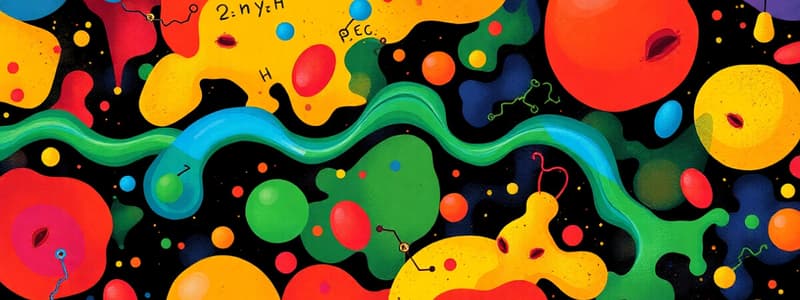Podcast
Questions and Answers
How would significantly increasing the temperature affect enzyme function?
How would significantly increasing the temperature affect enzyme function?
- It will have no effect as enzymes are stable across a wide temperature range.
- It will increase the rate of reaction by providing more energy to the enzyme.
- It will cause denaturation by disrupting the enzyme's shape. (correct)
- It will cause the enzyme to bind more tightly to the substrate.
If an enzyme's active site is complementary to a specific substrate, what would happen if a molecule with a very different shape entered the active site?
If an enzyme's active site is complementary to a specific substrate, what would happen if a molecule with a very different shape entered the active site?
- The enzyme would denature and become non-functional.
- The enzyme would change shape to accommodate the new molecule and catalyze a new reaction.
- The enzyme would still catalyze the reaction, but with a higher activation energy.
- The molecule would not bind effectively, and the reaction rate would be minimal. (correct)
Which of the following correctly describes the relationship between monomers and polymers, providing an example of each?
Which of the following correctly describes the relationship between monomers and polymers, providing an example of each?
- Monomers are large, complex structures made of repeating polymer subunits, such as a protein made of multiple carbohydrate molecules.
- Polymers are single-unit building blocks that combine to form monomers, such as fatty acids forming a lipid.
- Monomers are single-unit building blocks that combine to form polymers, such as amino acids forming a protein. (correct)
- Polymers and monomers are the same thing; the terms are interchangeable in biochemistry.
Hemoglobin is a protein found in red blood cells. Based on its function, which of the following is most likely?
Hemoglobin is a protein found in red blood cells. Based on its function, which of the following is most likely?
Which of the biomolecules below are used by organisms as sources of energy?
Which of the biomolecules below are used by organisms as sources of energy?
Flashcards
Active Site
Active Site
The specific region of an enzyme where the substrate binds and the reaction occurs.
Substrate
Substrate
A molecule that binds to the active site of an enzyme, initiating a reaction.
Denaturation
Denaturation
Loss of an enzyme's shape due to heat or pH, causing it to stop working.
Organic compound
Organic compound
Signup and view all the flashcards
Polymer
Polymer
Signup and view all the flashcards
Study Notes
- Enzymes has a pocket on their surface called an active site
- The molecule that fits in to the active site is called the substrate
- The reaction takes place at the active site
- The products of the reactions are released
- The diagram shows the substrate, enzyme, active site, and product
- Enzyme activity can be affected by temperature and pH levels
- Enzymes denature and lose shape after being exposed to extremely high heat
Polymers vs Monomers
- A monomer is a single piece, while a polymer is made of monomers put together
Organic compounds as energy sources
- Protein, carbohydrates, and lipids are organic compounds that act as sources of energy to organisms
Proteins
- Proteins differentiate from one another by their shape
Hemoglobin
- Hemoglobin is a protein where its function is to carry oxygen
Enzyme/Substrate Relationship Analogy
- Enzymes and substrates have a lock and key relationship
Denaturation
- Denaturation effects the change of shape
Organic vs Inorganic compounds
- Organic compounds will have carbon, while inorganic do not.
- One is abiotic and one is biotic.
Studying That Suits You
Use AI to generate personalized quizzes and flashcards to suit your learning preferences.




